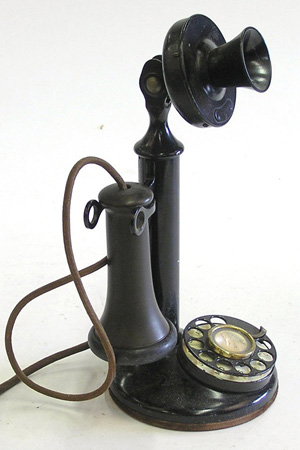
Wally Tubbs loves his phones, too. He loves this phone. And that phone. And those phones over there. He loves candlestick phones and princess phones, fiddleback phones and old-time silver dollar phone booths.
Tubbs knows phones, what makes them work, how they’ve evolved, which phones went over big (the Ericafone) which phones flopped (the camera phone).
The hundreds of phones at the Frank H. Woods Telephone Pioneer Museum don’t technically belong to the retired Lincoln Telephone Co. employee, although he is president of something called The Pioneer Association – a group of former and current telephone company employees that run the place.
And he does volunteer his time to lead tours here at 21st and M streets, where a portrait of Frank H. Woods hangs in a replica of his old office.
The museum is named for Frank H. Woods Sr. (1868-1952) who founded Lincoln Telephone Co. 1903. The company began serving 1,800 Lincoln customers in June 1904. Telephony, an industry publication, praised the new company as “the first large automatically operated telephone exchange west of Chicago.”
And where some pretty nifty mannequins – all women – man an impressive old-time switchboard.
And you can tell – listening to him – that even though texting isn’t yet his forte, Tubbs is committed to our favorite form of communication in all of its historical permutations.
And that he’s worried about this museum.
The valuable archive of telephone history – from Alexander Graham Bell to the BlackBerry – sits in the middle of the Antelope Valley (community revitalization) Project.
The low-slung white building is owned by Windstream Communications, and board members worry developers will gobble it up and give them the boot.
Not yet, say Windstream’s vice president of operations in Nebraska, Brad Hedrick, and the company’s PR man on speakerphone from Little Rock, Ark.
But that doesn’t mean it couldn’t happen.
The company provides the building rent-free to the museum. But if the land were sold, Windstream would not provide the museum a new home, Hedrick said.
Which is why Tubbs and his Pioneer Association board members are trying to let people know the museum exists and that it would like to continue to exist.
They don’t have a budget, Tubbs says. They don’t have a marketing arm.
Schoolchildren can tour the museum by appointment during the week. (Most common question: What’s that dial for?)
On Sunday afternoons from 1 to 4 p.m., anyone can walk in the door and see where their Droid got its start.
The museum has the phone world’s Lucy – the Gallows phone – and most of the models that followed.
This place is a well-kept secret, Tubbs said on a recent winter morning. At least locally.
It’s been on the radar of phonatics since it opened in 1996. Jim Carrey’s Yes Man gave it another boost when the museum was featured in a scene (filmed in California with memorabilia from Lincoln and a sign “Come to the Frank H. Woods Telephone Pioneer Museum Today” that doesn’t exist).
With an uncertain future, museum supporters would like more people to see what’s inside. And the effort it took to get it there – like needing a crane to remove an old switchboard intact from the eighth floor of the old Lincoln Telephone building. And phone company employees like Al Farmer scouring the countryside for phone memorabilia. He shows the place off with Tubbs – beautiful antique phones made of walnut and brass and oak. And vintage phones from the ’50s and ’60s, in every color of the rainbow.
Tubbs looks through the glass at the sleek lines of the “automatic electric AE34.”
“To me that’s a piece of art, not a phone.”
There is a lot of history in the museum on M Street – and in the building itself, constructed as a filling station in 1956.
Tubbs knows time brings change. And that Windstream’s Hedrick has been more than good to them.
But Windstream, with its headquarters in Arkansas, is a long way from Frank Woods and his Lincoln phone empire.
And landlines are going the way of the party line.
The double-walled phone booth no longer exists outside of museums and movie sets. It doesn’t take a room of switchboard operators to connect us.
The Antelope Valley Project is the big kid on the block.
But Tubbs also believes there is value in history. Hello? Can you hear him?
___
Information from: Lincoln Journal Star,
http://www.journalstar.com
Copyright 2011 Associated Press. All rights reserved. This material may not be published, broadcast, rewritten or redistributed.
AP-CS-02-13-11 0102EST

